Abstract
1 Pindolol is a β-adrenoceptor blocking drug with ISA (also called partial agonist activity). This means that in addition to blocking the effects of β-adrenoceptor agonists, it produces some stimulation of β-adrenoceptors.
2 In vitro studies with pindolol show that its maximum stimulant action is similar to that of isoprenaline in tissues possessing mainly β2-adrenoceptors, but is negligible in tissues possessing mainly β1-adrenoceptors. This suggests selective stimulation of β2-adrenoceptors.
3 In man the arteriodilator effects observed after intra-arterially infused pindolol at concentrations within the same range as those producing an antihypertensive effect also suggest a stimulant action on vascular β2-adrenoceptors.
4 The fact that pindolol prevents the reduction of resting heart rate and cardiac output observed after drugs lacking ISA at first sight suggests stimulation of cardiac β1-adrenoceptors. However, human atria possess not only β1- but also β2-adrenoceptors, stimulation of which would produce the same effect.
5 Although all β-adrenoceptor antagonists lower blood pressure, recent experiments have shown that those agents with combined β1-adrenoceptor blocking activity and ISA at those receptors are less effective. This observation lends weight to the thesis that pindolol does not stimulate β1-adrenoceptors since it lowers blood pressure as effectively as drugs lacking ISA.
6 The evidence available therefore suggests that although pindolol blocks both β1- and β2-subtypes, it selectively stimulates β2-adrenoceptors.
Keywords: pindolol, intrinsic sympathomimetic activity, β2-adrenoceptor
Full text
PDF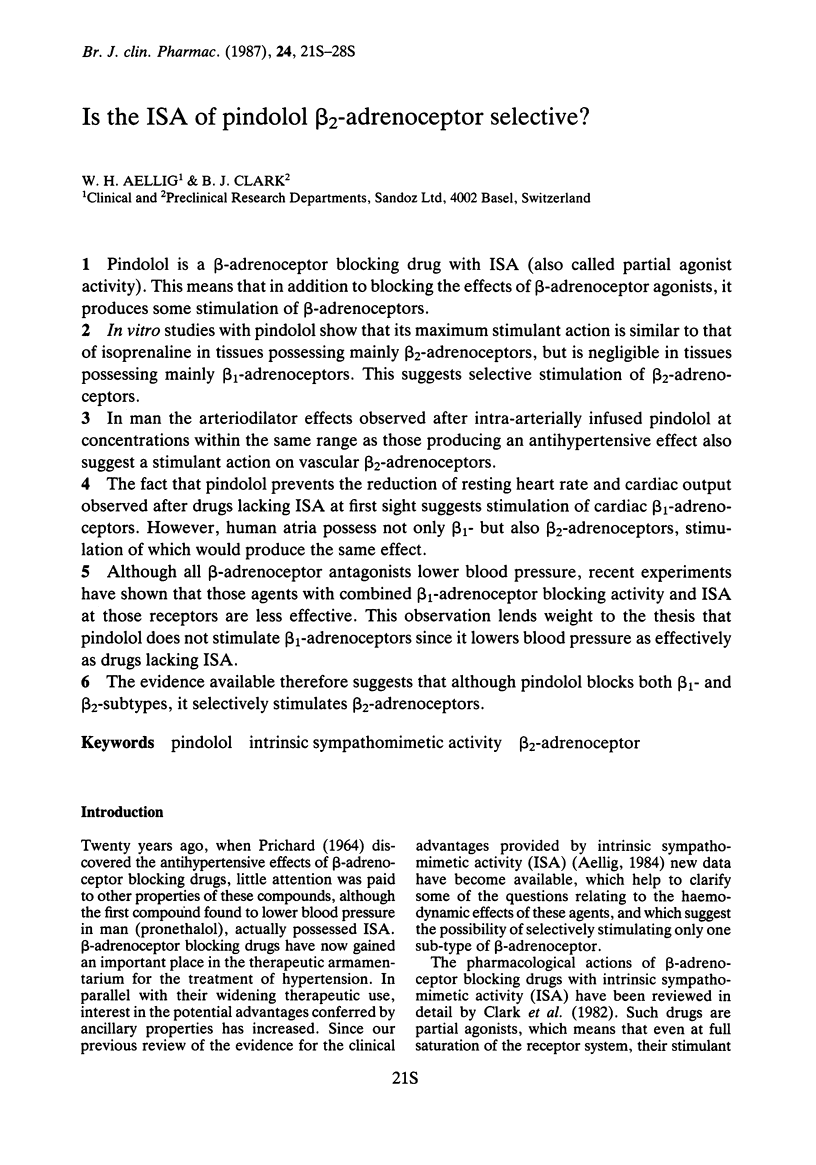
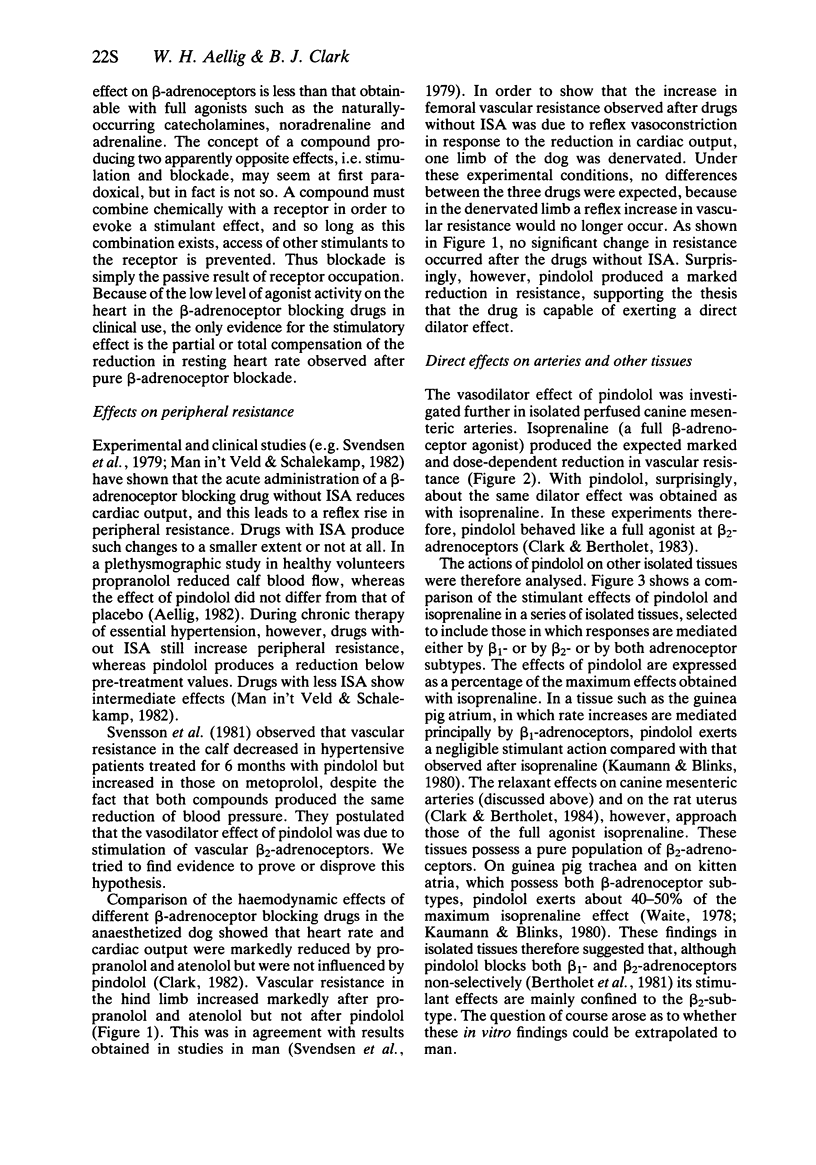

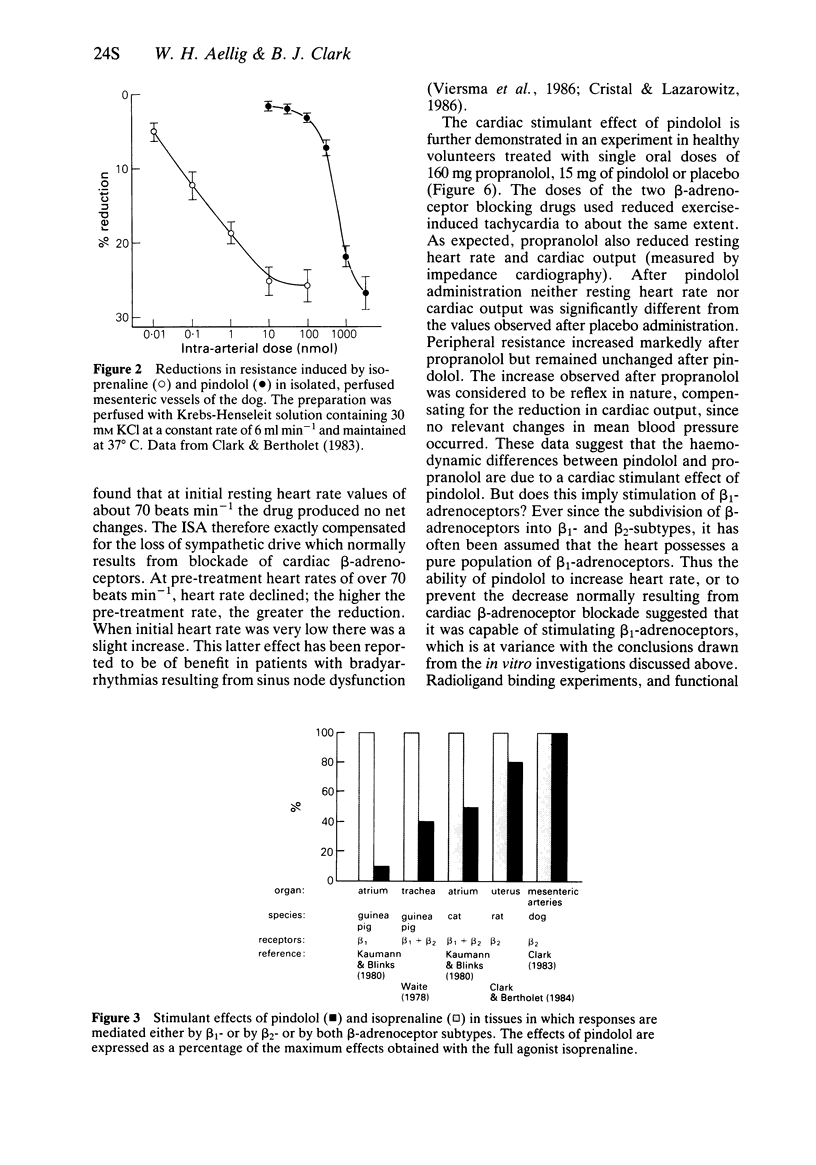
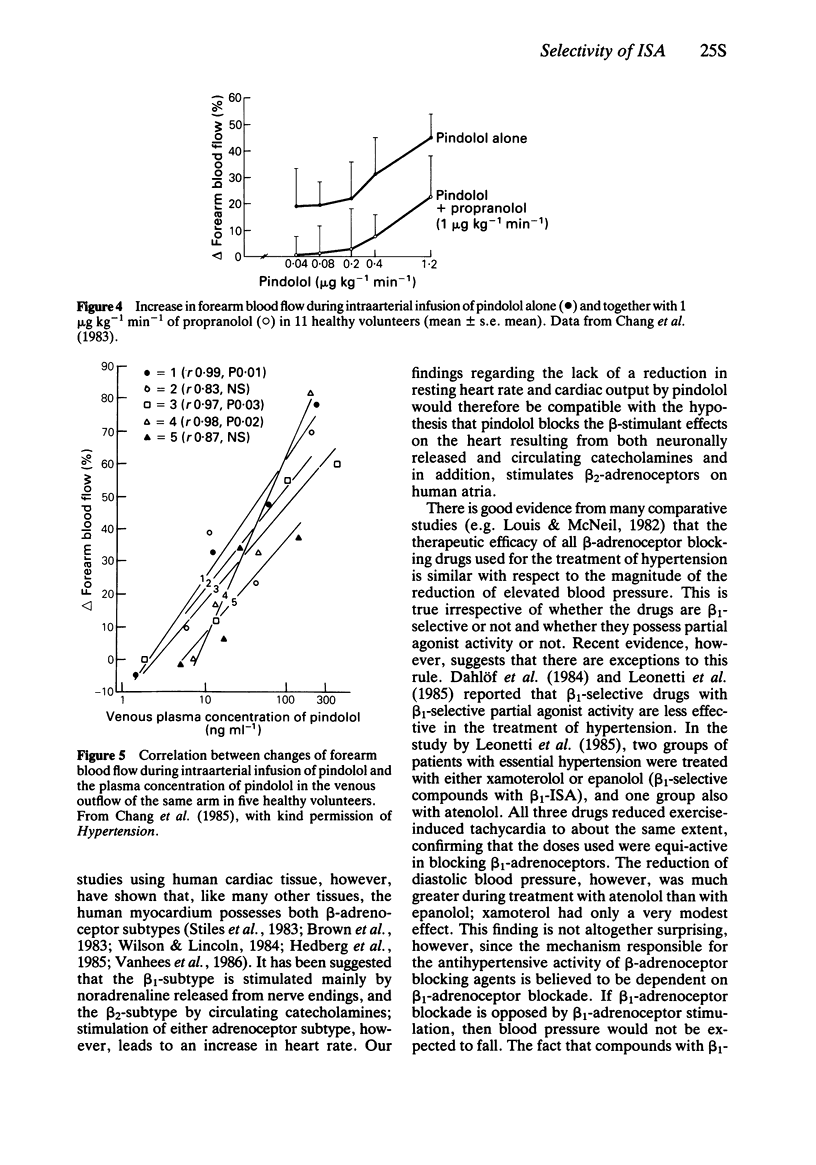

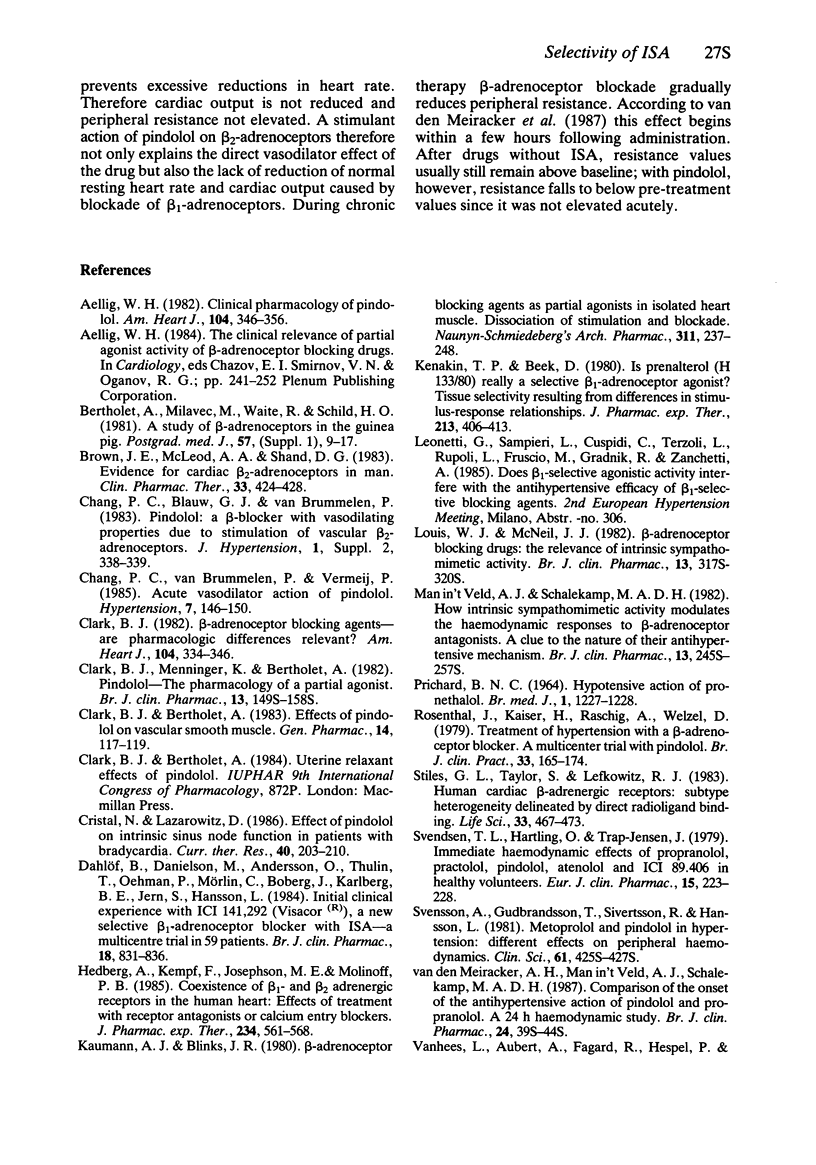
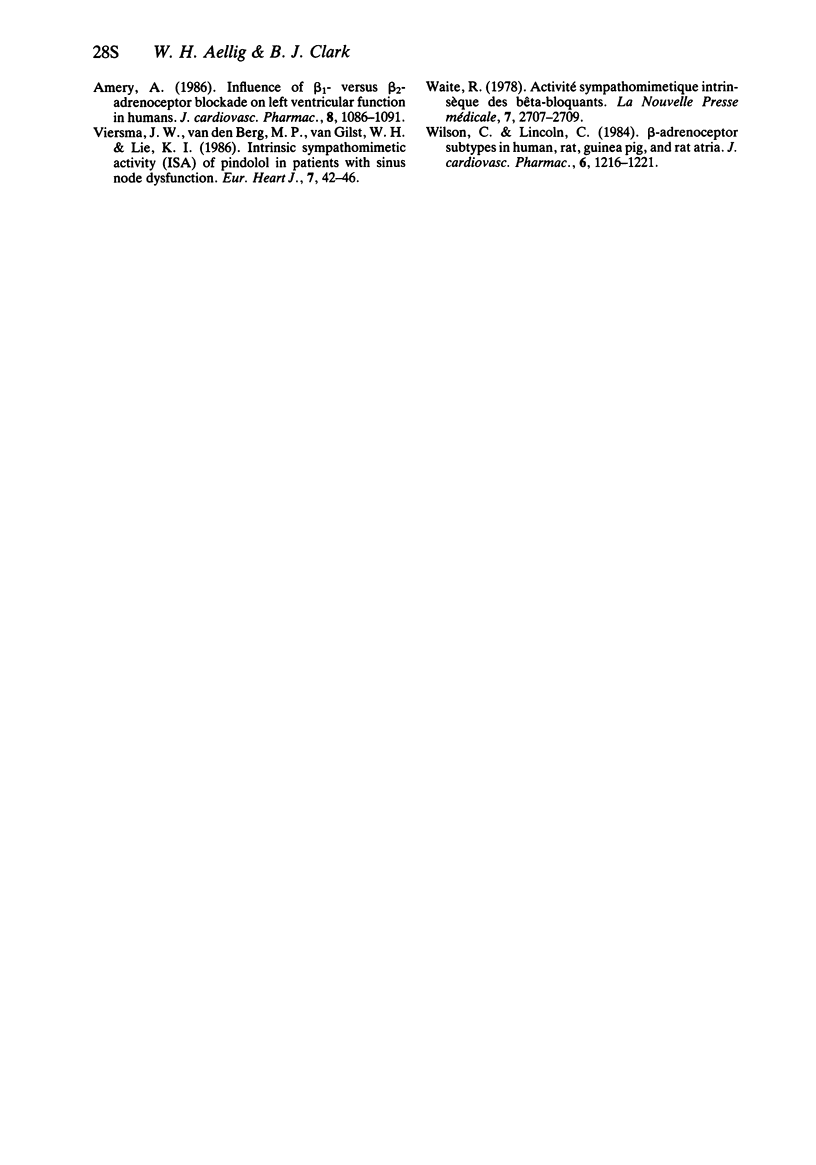
Selected References
These references are in PubMed. This may not be the complete list of references from this article.
- Aellig W. H. Clinical pharmacology of pindolol. Am Heart J. 1982 Aug;104(2 Pt 2):346–356. doi: 10.1016/0002-8703(82)90125-9. [DOI] [PubMed] [Google Scholar]
- Bertholet A., Milavec M., Waite R. A study of beta-adrenoceptors in the guinea pig. Postgrad Med J. 1981;57 (Suppl 1):9–17. [PubMed] [Google Scholar]
- Brown J. E., McLeod A. A., Shand D. G. Evidence for cardiac beta 2-adrenoceptors in man. Clin Pharmacol Ther. 1983 Apr;33(4):424–428. doi: 10.1038/clpt.1983.57. [DOI] [PubMed] [Google Scholar]
- Chang P. C., van Brummelen P., Vermeij P. Acute vasodilator action of pindolol in humans. Hypertension. 1985 Jan-Feb;7(1):146–150. doi: 10.1161/01.hyp.7.1.146. [DOI] [PubMed] [Google Scholar]
- Clark B. J., Bertholet A. Effects of pindolol on vascular smooth muscle. Gen Pharmacol. 1983;14(1):117–119. doi: 10.1016/0306-3623(83)90078-2. [DOI] [PubMed] [Google Scholar]
- Clark B. J. Beta-adrenoceptor-blocking agents: are pharmacologic differences relevant? Am Heart J. 1982 Aug;104(2 Pt 2):334–346. doi: 10.1016/0002-8703(82)90124-7. [DOI] [PubMed] [Google Scholar]
- Clark B. J., Menninger K., Bertholet A. Pindolol--the pharmacology of a partial agonist. Br J Clin Pharmacol. 1982;13(Suppl 2):149S–158S. doi: 10.1111/j.1365-2125.1982.tb01904.x. [DOI] [PMC free article] [PubMed] [Google Scholar]
- Dahlöf B., Danielson M., Andersson O., Thulin T., Ohman P., Mörlin C., Boberg J., Karlberg B. E., Jern S., Hansson L. Initial clinical experience with ICI 141,292 (Visacor), a new selective beta 1-adrenoceptor blocker with ISA--a multicentre trial in 59 patients. Br J Clin Pharmacol. 1984 Dec;18(6):831–836. doi: 10.1111/j.1365-2125.1984.tb02552.x. [DOI] [PMC free article] [PubMed] [Google Scholar]
- Hedberg A., Kempf F., Jr, Josephson M. E., Molinoff P. B. Coexistence of beta-1 and beta-2 adrenergic receptors in the human heart: effects of treatment with receptor antagonists or calcium entry blockers. J Pharmacol Exp Ther. 1985 Sep;234(3):561–568. [PubMed] [Google Scholar]
- Kaumann A. J., Blinks J. R. beta-Adrenoceptor blocking agents as partial agonists in isolated heart muscle: dissociation of stimulation and blockade. Naunyn Schmiedebergs Arch Pharmacol. 1980 Apr;311(3):237–248. doi: 10.1007/BF00569403. [DOI] [PubMed] [Google Scholar]
- Kenakin T. P., Beek D. Is prenalterol (H133/80) really a selective beta 1 adrenoceptor agonist? Tissue selectivity resulting from differences in stimulus-response relationships. J Pharmacol Exp Ther. 1980 May;213(2):406–413. [PubMed] [Google Scholar]
- Louis W. J., McNeil J. J. Beta-adrenoceptor blocking drugs: the relevance of intrinsic sympathomimetic activity. Br J Clin Pharmacol. 1982;13(Suppl 2):317S–320S. doi: 10.1111/j.1365-2125.1982.tb01935.x. [DOI] [PMC free article] [PubMed] [Google Scholar]
- Man in 't Veld A. J., Schalekamp M. A. How intrinsic sympathomimetic activity modulates the haemodynamic responses to beta-adrenoceptor antagonists. A clue to the nature of their antihypertensive mechanism. Br J Clin Pharmacol. 1982;13(Suppl 2):245S–257S. doi: 10.1111/j.1365-2125.1982.tb01922.x. [DOI] [PMC free article] [PubMed] [Google Scholar]
- PRICHARD B. N. HYPOTENSIVE ACTION OF PRONETHALOL. Br Med J. 1964 May 9;1(5392):1227–1228. doi: 10.1136/bmj.1.5392.1227. [DOI] [PMC free article] [PubMed] [Google Scholar]
- Rosenthal J., Kaiser H., Raschig A., Welzel D. Treatment of hypertension with a beta-adrenoceptor blocker. A multicentre trial with pindolol. Br J Clin Pract. 1979 Jun;33(6):165-74, 181. [PubMed] [Google Scholar]
- Stiles G. L., Taylor S., Lefkowitz R. J. Human cardiac beta-adrenergic receptors: subtype heterogeneity delineated by direct radioligand binding. Life Sci. 1983 Aug 1;33(5):467–473. doi: 10.1016/0024-3205(83)90796-8. [DOI] [PubMed] [Google Scholar]
- Svendsen T. L., Hartling O., Trap-Jensen J. Immediate haemodynamic effects of propranolol, practolol, pindolol, atenolol and ICI 89,406 in healthy volunteers. Eur J Clin Pharmacol. 1979 May 21;15(4):223–228. doi: 10.1007/BF00618509. [DOI] [PubMed] [Google Scholar]
- Svensson A., Gudbrandsson T., Sivertsson R., Hansson L. Metoprolol and pindolol in hypertension: different effects on peripheral haemodynamics. Clin Sci (Lond) 1981 Dec;61 (Suppl 7):425s–427s. doi: 10.1042/cs061425s. [DOI] [PubMed] [Google Scholar]
- Vanhees L., Aubert A., Fagard R., Hespel P., Amery A. Influence of beta 1- versus beta 2-adrenoceptor blockade on left ventricular function in humans. J Cardiovasc Pharmacol. 1986 Sep-Oct;8(5):1086–1091. doi: 10.1097/00005344-198609000-00030. [DOI] [PubMed] [Google Scholar]
- Viersma J. W., van den Berg M. P., van Gilst W. H., Lie K. I. Intrinsic sympathomimetic activity (ISA) of pindolol in patients with sinus node dysfunction. Eur Heart J. 1986 Jan;7(1):42–46. doi: 10.1093/oxfordjournals.eurheartj.a061956. [DOI] [PubMed] [Google Scholar]
- Waite R. Activité sympathomimétique intrinsèque des bêta-bloquants. Nouv Presse Med. 1978 Sep 20;7(31):2707–2709. [PubMed] [Google Scholar]
- Wilson C., Lincoln C. Beta-adrenoceptor subtypes in human, rat, guinea pig, and rabbit atria. J Cardiovasc Pharmacol. 1984 Nov-Dec;6(6):1216–1221. [PubMed] [Google Scholar]
- van den Meiracker A. H., Man in't Veld A. J., Schalekamp M. A. Comparison of the onset of the antihypertensive action of pindolol and propranolol. A 24 h haemodynamic study. Br J Clin Pharmacol. 1987;24 (Suppl 1):39S–44S. doi: 10.1111/j.1365-2125.1987.tb03267.x. [DOI] [PMC free article] [PubMed] [Google Scholar]


